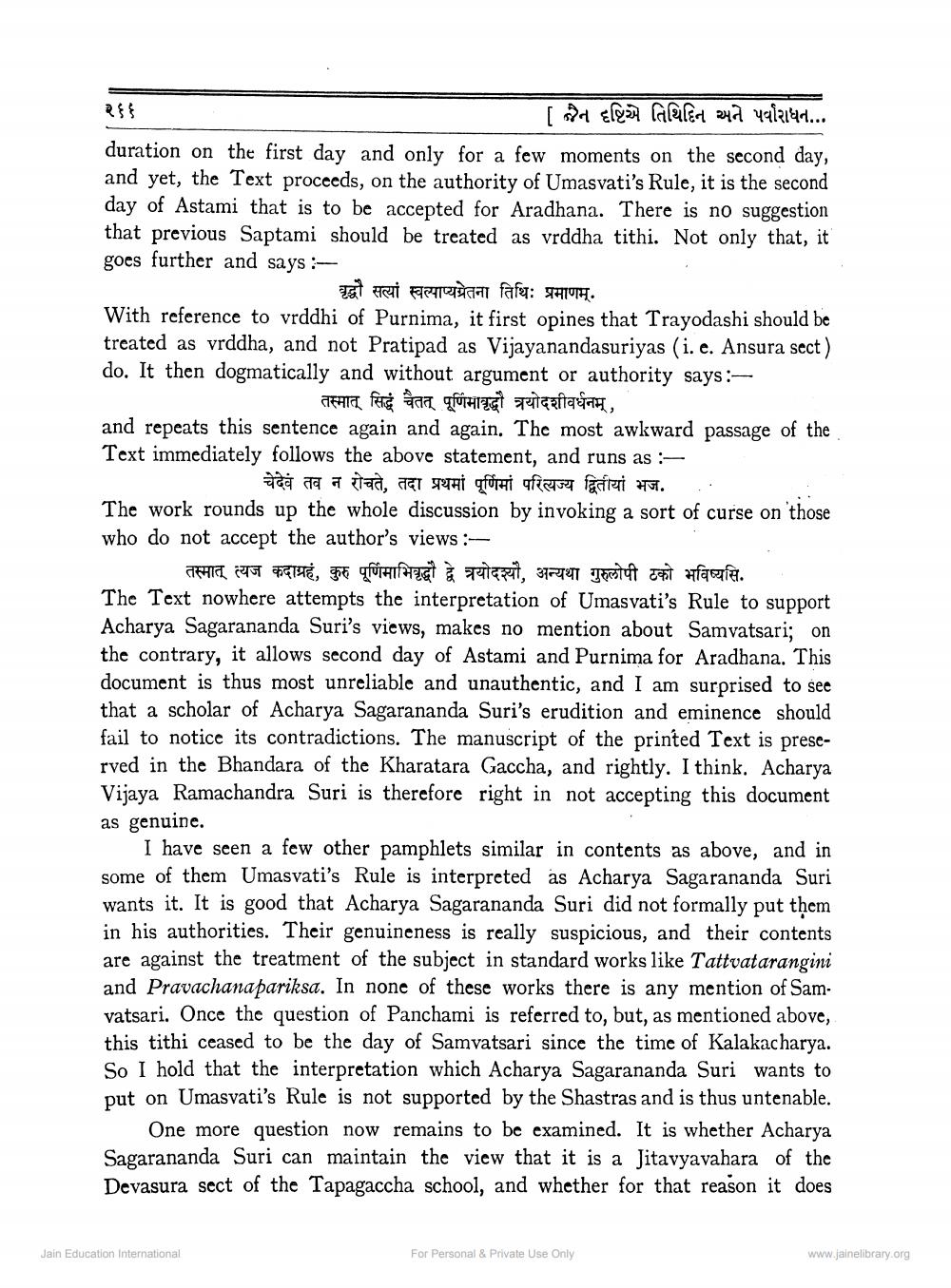________________
[જૈન દૃષ્ટિએ તિથિદિન અને પર્વોરાધન... duration on the first day and only for a few moments on the second day, and yet, the Text proceeds, on the authority of Umasvati's Rule, it is the second day of Astami that to be accepted for Aradhana. There is no suggestion that previous Saptami should be treated as vrddha tithi. Not only that, it goes further and says:
૨૬
वृद्धौ सत्यां स्वत्पाप्यग्रेतना तिथिः प्रमाणम्.
With reference to vrddhi of Purnima, it first opines that Trayodashi should be treated as vrddha, and not Pratipad as Vijayanandasuriyas (i. e. Ansura sect) do. It then dogmatically and without argument or authority says:
तस्मात् सिद्धं चैतत् पूर्णिमावृद्ध त्रयोदशीवर्धनम्,
and repeats this sentence again and again. The most awkward passage of the Text immediately follows the above statement, and runs as :
चेदेवं तव न रोचते, तदा प्रथमां पूर्णिमां परित्यज्य द्वितीयां भज.
The work rounds up the whole discussion by invoking a sort of curse on those who do not accept the author's views:
तस्मात् त्यज कदाग्रहं कुरु पूर्णिमाभिवृद्धौ द्वे त्रयोदश्यौ, अन्यथा गुरुलोपी ठको भविष्यसि.
The Text nowhere attempts the interpretation of Umasvati's Rule to support Acharya Sagarananda Suri's views, makes no mention about Samvatsari; on the contrary, it allows second day of Astami and Purnima for Aradhana. This document is thus most unreliable and unauthentic, and I am surprised to see that a scholar of Acharya Sagarananda Suri's erudition and eminence should fail to notice its contradictions. The manuscript of the printed Text is preserved in the Bhandara of the Kharatara Gaccha, and rightly. I think. Acharya Vijaya Ramachandra Suri is therefore right in not accepting this document as genuine.
I have seen a few other pamphlets similar in contents as above, and in some of them Umasvati's Rule is interpreted as Acharya Sagarananda Suri wants it. It is good that Acharya Sagarananda Suri did not formally put them in his authorities. Their genuineness is really suspicious, and their contents are against the treatment of the subject in standard works like Tattvatarangini and Pravachanapariksa. In none of these works there is any mention of Samvatsari. Once the question of Panchami is referred to, but, as mentioned above, this tithi ceased to be the day of Samvatsari since the time of Kalakacharya. So I hold that the interpretation which Acharya Sagarananda Suri wants to put on Umasvati's Rule is not supported by the Shastras and is thus untenable.
One more question now remains to be examined. It is whether Acharya Sagarananda Suri can maintain the view that it is a Jitavyavahara of the Devasura sect of the Tapagaccha school, and whether for that reason it does
Jain Education International
For Personal & Private Use Only
www.jainelibrary.org




